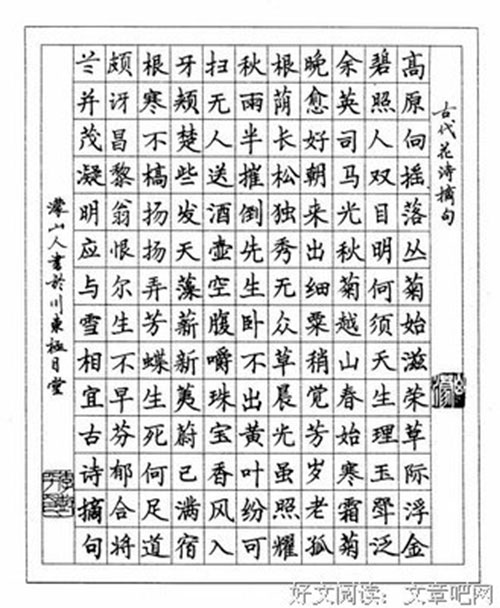There are people who say that Kaishu is the basic calligraphy technique. Is this statement true?
In order to understand what the basic calligraphy technique is, it is necessary to understand the relationship between styles, elements and techniques in calligraphy.
First of all, there are five styles (types of writing): Zhuanshu, Lishu, Kaishu, Xingshu and Tsaoshu in calligraphy. In addition, the three main elements are distinguished: writing lines, writing a hieroglyph and composition. To achieve these three elements, a number of tricks are required.
In creating each of the five styles, the three elements are used differently, and the techniques used to implement these three elements are also different. Thus, it is precisely the three elements rational implementation techniques is the calligraphy skill (or the basic calligraphy technique). Kaishu is only one of five styles, and if it is performed perfectly, it doesn’t mean that Zhuanshu, Xingshu, Tsaoshu or Lishu will work out well, and this is not an indicator of the high level of your basic calligraphy technique. If the Kaishu is not performed “exemplary”, this does not mean that the basic technique is low.
Nor is it an indicator that if we say that the Kaishu is poorly written, then other styles, such as Zhuanshu, Lishu and Xingshu, will necessarily be poorly written. All five calligraphic styles have their own relatively independent systems, there are auxiliary relations with each other between them, but there are no defining relations.
But writing lines (also called the “brush method”) and writing a character directly affect the quality of good characters among the three elements of calligraphy, and composition means processing the space between the characters, layout issues.
The basic writing lines technique
Writing lines (also called the “brush method”) in all five styles has its similarities and differences. The similarity is that the most important is the use of a “concentrated tip” (the brush direction is strictly vertical to the paper), which seems to be a strict requirement in all five styles. And the difference is that the requirements for the “concentrated tip” itself are different in all styles. So, in all styles, it differs in how you need to change the direction of the “concentrated tip” to the “oblique tip”, how to move the brush with a “concentrated tip”, how to start writing, how to take off the brush, how to make bends. It is much better to understand all the ways of brush movement of different styles and thus develop better practical skills than just writing the usual features of a Kaishu writing.
So, in the Kaishu writing the brush method is static, and in a Xingshu – dynamic, all the features in Kashu are drawn separately, and in Xingshu the whole process merges into one, and this method is even more difficult to implement than Kaishu. If you fully master and apply any of the brush methods of five styles, then the basic skills will be more durable. Of course, as you master the techniques of using the brush, the basic technique itself will deepen.
The basic technique for writing a character
The writing of characters in all five styles is also different. So, in Kaishu there are 36 tricks for writing a hieroglyph, in Xingshu writing hieroglyphs is not limited to any tricks (or, in other words, there are much more tricks for Xingshu), you just need to write freely and naturally, and in the Tsaoshu the writing of the hieroglyph is even more variable, besides in different types of Tsaoshu (xiaotsao and datsao), it also differs. The more techniques you learn and apply, the more the basic calligraphy techniques will be strengthened.
Basic composition technique
As for the rational use of the composition, it is also very important in creativity, it is also part of the basic calligraphy technique.
Therefore, the expression “Kaishu is the basic calligraphy technique” is not completely correct. If Kaishu is well done, this means that the techniques for writing Kaishu are well mastered. But the Kaishu techniques are not the same with the Xingshu, Tsaoshu and other styles techniques,. Only the ability to perfectly control the brush method and writing the character is the main skill and basic technique of calligraphy.
At the calligraphy study initial stage, good Kaishu skills can be useful for Xingshu and other styles, since Kaishu has bright patterns in the brush method and writing characters. When studying calligraphy, it is just necessary to first master these noticeable patterns, and only then move on to studying styles with relatively higher freedom in this regard. In connection with this, the development of the basic brush method and writing Kaishu characters can facilitate the transition to other styles. At the advanced stage of calligraphy, Kaishu, like Tsaoshu, also has a high artistic level.
It can be said that the real basic calligraphy technique is the general ability to express three calligraphy skills, which includes the ability to control the brush, the ability to control the writing of a character, the ability to control “ink methods”, and the ability to control layout and composition. In other words, the basic calligraphy technique is “the general level ability of the calligraphic management methods of using the brush method, the ink method and composition”. If you have this awareness, you can understand that a person who has strong skills in copying all writing styles will have higher skills, than the one who only knows how to write exemplary Kaishu.

